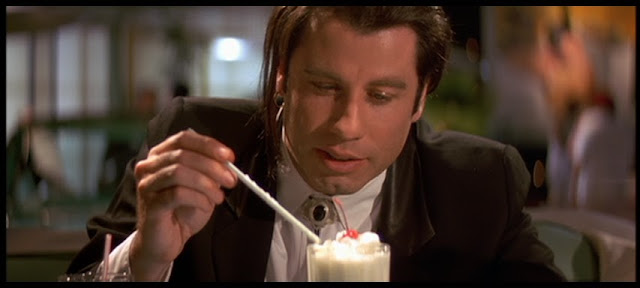Vincent Vega and Mia Wallace do the twist at Jack Rabbit Slim's. Note the black and white color theme of their clothing.

The classic black and white Taoist Taijitsu, the symbol for the Chinese yin yang. Many natural dualities — e.g. dark and light, female and male, low and high, cold and hot — are thought of as manifestations of yin and yang (respectively). [Image from the Wikipedia 'Yin and yang' page, public domain, via Wikimedia Commons.]
Mia and Vincent represent yin and yang, respectively, and can be considered to be complements of each other.


Top left: When Vincent arrives at the entrance to the Wallace home, he sees Mia's note on the front door. The note says, "Hi Vincent, I'm getting dressed. The doors open. Come inside and make yourself a drink." While we in the audience are being shown the note, as Vincent looks at it, we hear the voice of Mia speaking the words contained in it as if she here represents Vincent's own 'inner voice' speaking to him. Top right: Mia's level of hospitality is such that it is almost as if Vincent is being 'invited' into his own home, as suggested by this view of Vincent by himself in the home's living area. Above left: While Vincent is in the house, he hears Mia's voice (shown here is a profile view of Mia speaking into a microphone) on the home's intercom, talking to him, yet he cannot see her - again suggesting the idea that it is his own thoughts that he is hearing. In fact, the name 'Mia' itself suggests the word 'me' - me, as in Vincent. Above right: Once Vincent has been guided by Mia to the living area's intercom box, he can begin to converse with her.


After Mia and Vincent have left the Wallace home, and arrived at Jack Rabbit Slim's, they sit at a table and are waited on (top left), and then they begin to converse with each other (top right and above left). During this conversation we learn that each has (separately) spent a fair amount of time in the city of Amsterdam. The point is that there is some underlying connection being drawn between the two of them. When Vincent asks if he can have a taste of Mia's milkshake, she offers it to him, and he starts to take out her straw (above right), at which point she says, "You can use my straw - I don't have cooties." Vincent responds, "Yeah, but maybe I do." She then says, "Cooties I can handle", and he replies, "Alright." The idea of two people sharing a straw, when considered in the context of non-transmission of germs, is similar to the idea of one person alone using it; therefore, this part of Mia and Vincent's conversation is still another hint of an underlying connection between them: As stated above, they are complements of each other.
These two characters, Mia Wallace and Vincent Vega, represent the complementarity of female and male, together comprising a universal 'one-ness' in accordance with the Chinese philosophy of yin-yang. Mia represents the 'woman' within Vincent, and Vincent represents the 'man' within Mia.




